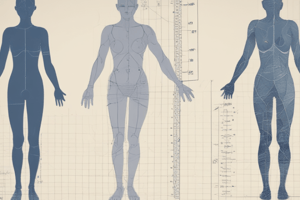Podcast
Questions and Answers
What is the primary function of the transversus abdominis (TrA) muscle?
What is the primary function of the transversus abdominis (TrA) muscle?
- To increase the length of the spine by imbibing fluid into the intervertebral discs
- To provide dynamic control to the motion segment, particularly in its neutral zone
- To provide rotational and lateral control to the spine while maintaining intra-abdominal pressure (correct)
- To control the movement of the sacroiliac joint during walking and limb movements
Which muscle is considered to have the greatest potential to provide dynamic control to the motion segment, particularly in its neutral zone?
Which muscle is considered to have the greatest potential to provide dynamic control to the motion segment, particularly in its neutral zone?
- Transversus abdominis
- Lumbar multifidus (correct)
- Diaphragm
- Internal oblique
What happens to the intervertebral discs when the osmotic pressure within them is greater than the hydrostatic pressure from axial loading?
What happens to the intervertebral discs when the osmotic pressure within them is greater than the hydrostatic pressure from axial loading?
- They dehydrate, causing the spine to decrease in length
- They become more rigid, limiting spinal movement
- They exert pressure on the zygapophyseal joints, causing pain
- They imbibe fluid, causing the spine to increase in length (correct)
What is the recommended advice for patients regarding spinal movements shortly after rising from bed?
What is the recommended advice for patients regarding spinal movements shortly after rising from bed?
Which muscle contributes to the control of sacroiliac movement?
Which muscle contributes to the control of sacroiliac movement?
What is the function of the coactivation of the diaphragm and abdominal muscles?
What is the function of the coactivation of the diaphragm and abdominal muscles?
Which of the following statements about the intervertebral discs (IVDs) is correct?
Which of the following statements about the intervertebral discs (IVDs) is correct?
What is the clinical significance of the attachment of the annulus fibrosus (AF) to the vertebral end plates?
What is the clinical significance of the attachment of the annulus fibrosus (AF) to the vertebral end plates?
Which of the following statements about the vertebral end plates is correct?
Which of the following statements about the vertebral end plates is correct?
Which of the following statements about lumbar spine flexion is correct?
Which of the following statements about lumbar spine flexion is correct?
What is the term used to describe the repetitive contact of the spinous processes during the extremes of lumbar extension?
What is the term used to describe the repetitive contact of the spinous processes during the extremes of lumbar extension?
What is the consequence of the condition known as 'kissing spine'?
What is the consequence of the condition known as 'kissing spine'?
Where are the attachment sites for the multifidus muscle located?
Where are the attachment sites for the multifidus muscle located?
Which statement about the zygapophyseal articular processes (facets) is correct?
Which statement about the zygapophyseal articular processes (facets) is correct?
What is the unique feature of the intervertebral disks in the lumbar spine?
What is the unique feature of the intervertebral disks in the lumbar spine?
What is the characteristic shape of the vertebral foramen in the lumbar spine?
What is the characteristic shape of the vertebral foramen in the lumbar spine?
Which statement about the fifth lumbar vertebra is correct?
Which statement about the fifth lumbar vertebra is correct?
What is the primary function of the intervertebral disks in the lumbar spine?
What is the primary function of the intervertebral disks in the lumbar spine?
Flashcards are hidden until you start studying
Study Notes
Osmotic Pressure and Disk Imbibition
- When osmotic pressure within the intervertebral disk (IVD) is greater than hydrostatic pressure from axial loading, the disk imbibe fluid, causing the spine to increase in length.
- This occurs when lying in bed, and patients should avoid performing full-range spinal motions (bending) shortly after rising from bed.
Transversus Abdominis and Spinal Control
- The transversus abdominis (TrA) is the deepest abdominal muscle, which may have a presetting role in providing rotational and lateral control to the spine.
- The TrA, along with the internal oblique, maintains adequate levels of intra-abdominal pressure and imparts tension to the thoracolumbar fascia, increasing the stiffness of the lumbar spine.
Diaphragm and Abdominal Muscle Coactivation
- Coactivation of the diaphragm and abdominal muscles produces a sustained increase in intra-abdominal pressure.
- Activity of the diaphragm and TrA is initiated before rapid limb movements and is tonic during repetitive movements of the arm and walking.
Lumbar Multifidus and Dynamic Control
- The lumbar multifidus is considered to have the greatest potential to provide dynamic control to the motion segment, particularly in its neutral zone.
Intervertebral Disk Function
- The intervertebral disk (IVD) acts to provide flexibility at low loads and stability at high loads.
- The IVD distributes compressive stress evenly between adjacent vertebrae due to the nucleus pulposus and inner anulus fibrosus acting like a pressurized fluid.
Vertebral End Plates and Attachment
- The vertebral end plates are strongly bound to the IVD, whereas they are only weakly attached to the vertebral bodies.
- The end plates are considered constituents of the IVD, rather than part of the lumbar vertebral body.
Age-related Changes in Intervertebral Disk
- The IVD becomes drier, stiffer, less deformable, and less able to recover from creep with age.
Lumbar Spine Flexion and Posterior Pelvic Tilt
- Flexion of the lumbar spine can occur with a posterior pelvic tilt, which can be performed voluntarily or as a result of weak paraspinal extensor muscles or adaptively shortened hamstring and gluteal muscles.
Repetitive Contact and Periostitis
- Repetitive contact of the spinous processes during the extremes of lumbar extension can lead to a periostitis called "kissing spine", resulting in ligamentous laxity and hypermobility of the segment.
Vertebral Anatomy
- The lumbar vertebra has a massive body, pedicles, laminae, transverse process, accessory processes, and spinous process.
- The fifth lumbar vertebra is a transitional vertebra, with a wedgeshaped body and specific characteristics.
Intervertebral Disk Structure
- The intervertebral disk consists of anulus fibrosus and nucleus pulposus, with collagen fibers arranged in concentric sheets (lamellae).
- The disk resists tensile forces in nearly all directions and provides a greater cross-sectional area of anulus fibrosus posteriorly, increasing its ability to resist tension.
Studying That Suits You
Use AI to generate personalized quizzes and flashcards to suit your learning preferences.





